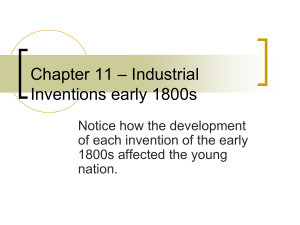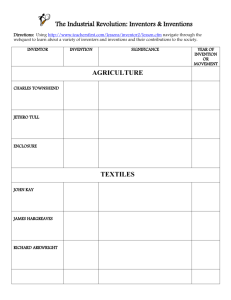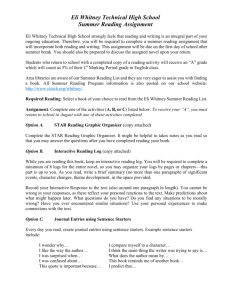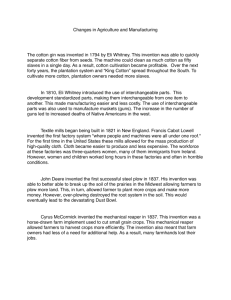American Free Enterprise-...make your own $ choices
advertisement
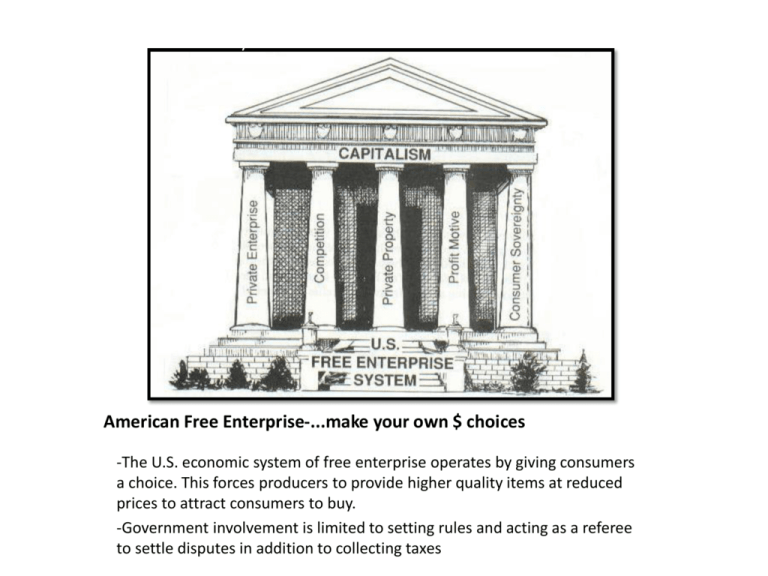
The American Economy American Free Enterprise-...make your own $ choices -The U.S. economic system of free enterprise operates by giving consumers a choice. This forces producers to provide higher quality items at reduced prices to attract consumers to buy. -Government involvement is limited to setting rules and acting as a referee to settle disputes in addition to collecting taxes Factors that lead to industrialization and urbanization • Factors that lead to industrialization and urbanization • • • • • Natural Resources Transportation Investment capitol ($$$) New Inventions Population (immigration & high birth rates) • What drives Innovation? (something new/different) • The need to make something better----CHANGE • The Industrial Revolution is the change from handmade to machine made products. • As the Industrial Revolution spread, more and more goods were made in factories. People began to move to cities (urbanize) and buy more manufactured goods rather than make everything themselves. James Watt: Steam Engine Samuel F.B. Morse: telegraph and Morse code Robert Fulton: Steam boat Transportation and Communication Transcontinental Railroad DeWitt Clinton: Erie Canal STEAM ENGINE •Patented in 1871 by James Watt •Increased available power across the country, wherever water and coal or wood at hand •Affected transportation, manufacturing, and agriculture STEAMBOAT •Patented in the US by Robert Fulton in 1807 •Two-way river transportation became much easier •Affected commercial, private, and military transportation ERIE CANAL •Opened in 1825, promoter Dewitt Clinton •Thousands of workers were needed for this project. 25% of these workers were Irish. •This modification of the environment allowed the Great Lakes to be connected to the Hudson river •This connection made it cheaper and easier to get Midwestern farm products out to the ocean for trade and vice versa! TELEGRAPH •Patented by Samuel Morse in 1837 •Made long-distance communication faster and cheaper COTTON GIN •Invented by Eli Whitney in the 1790’s •Made removing seeds from cotton easier •Significant impact on the economy of the South •Probably prolonged slavery INTERCHANGEABLE PARTS •Eli Whitney standardized parts, making them interchangeable from one item to another. •This made manufacturing easier and less costly=CHEAPER products for consumers BESSEMER STEEL PROCESS •Invented by Henry Bessemer in the 1850’s •Made possible the manufacture of great amounts of high quality, less expensive steel •Contributed to higher quality machinery, farm implements, and transportation TEXTILE MILL •Developed by Francis Lowell in the 1820’s •Brought the entire manufacturing process under one roof •Contributed to urbanization and child labor practices Eli Whitney: Cotton Gin Agriculture Cyrus McCormick: Mechanical Reaper John Deere: Steel Plow STEEL PLOW •Invented by John Deere in 1837 •Allowed faming on tough Midwestern soils •“The Plow That Broke the Plains” MECHANICAL REAPER •Invented by Cyrus McCormick in the 1830’s •Reduced human and animal power needed to bring in crops •Increased efficiency- automatically cut, threshed and bundled grain IR effects the American Economy and Society • America was largely rural in the 1830’s. • The rise of industry changes this. • 1820-350,000 factory workers….by 1860 there are 2 MILLION factory workers! • People develop new work habits (time clocks, schedules) • Women and children enter the workforce along with immigrants • Needed more educated leaders and managers • Rapid industrialization brings increase in technology as well as societal problems.


